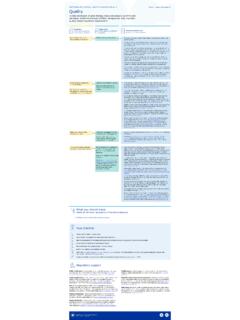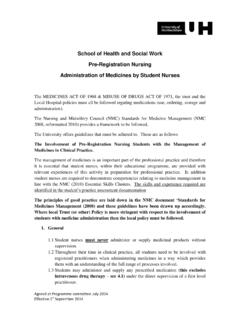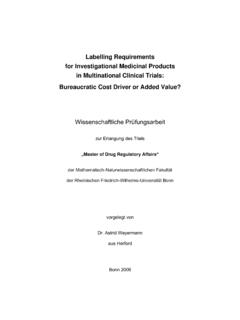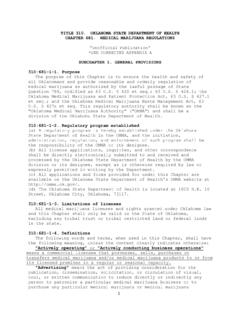Transcription of Pharmacovigilance Plan of the EU Regulatory Network for ...
1 Official address Domenico Scarlattilaan 6 1083 HS Amsterdam The Netherlands An agency of the European Union Address for visits and deliveries Refer to Send us a question Go to Telephone +31 (0)88 781 6000 European Medicines Agency, 2020. Reproduction is authorised provided the source is acknowledged. EMA/333964/2020 Pharmacovigilance Plan of the EU Regulatory Network for COVID-19 Vaccines its emergence in 2019, the SARS-Cov2 virus has spread to almost every country making the COVID-19 pandemic a global health crisis. COVID-19 vaccines once available are expected to play a major role in the control of the pandemic. While developed at unprecedented speed, they will only be authorised by European Union (EU) authorities if their benefits outweigh their risks based on data on efficacy, safety and quality.
2 During the development phase of any medicine, a limited number of selected participants are included in clinical trials and followed up for a relatively short duration under controlled conditions. As a result, certain side effects, particularly rare or very rare ones, only emerge during real life use in many different people. It is therefore essential to closely monitor the safety and effectiveness of any medicine after it is authorised. The uptake of COVID-19 vaccines once authorised is anticipated to be very high which may lead to a high volume of suspected adverse reaction reports and other safety data. Thus, the prompt detection and evaluation of new information on the benefit-risk balance of these vaccines, timely communication and a high level of transparency will be key to protect public health and ensure the public s trust in the vaccines and in the Regulatory system.
3 In view of the public health urgency and the extensive vaccination campaigns foreseen worldwide, the European Medicines Agency (EMA) and the national competent authorities (NCAs) in EU member states have prepared themselves for the expected high data volume by putting in place this Pharmacovigilance plan specific for COVID-19 vaccines. This is to ensure that all new information collected post-marketing will be promptly reviewed and any emerging new information will be shared with the public in a timely manner. The plan builds on the well-established Pharmacovigilance system of the EU Regulatory Network and the experience gained during the 2009 (H1N1) flu pandemic while taking into account the current specificities of the COVID-19 pandemic.
4 Present document provides an overview of the activities the EU Regulatory Network (EMA and NCAs) will conduct once COVID-19 vaccines are authorised. Pharmacovigilance Plan of the EU Regulatory Network for COVID-19 Vaccines EMA/333964/2020 Page 2/8 The legal provisions on pharmacovigilance1 and the extensive guidance developed by EMA in collaboration with NCAs set out in the good Pharmacovigilance practices (GVP), apply to all medicinal products authorised in the EU, including COVID-19 vaccines. This document focusses on the activities planned specifically for COVID-19 vaccines. The established processes and requirements for Pharmacovigilance in general are briefly noted where relevant to provide context.
5 Main objectives of this plan include: -Active collection of data on rare potential risks;-Rapid detection, prioritisation and assessment of emerging safety information derived fromspontaneous reporting systems, observational studies and other data sources;-Prompt evaluation of the impact of detected safety issues on the benefit-risk balance of thevaccines, taking into account exposure and effectiveness data;-Active surveillance of vulnerable populations, such as pregnant women and older vaccinees;-Engagement and collaboration with stakeholders including vaccinees and healthcare professionals,marketing authorisation holders (MAHs) and international partners;-Prompt and effective communication of new information arising from the above and responsibilitiesThe respective roles and responsibilities of MAHs, NCAs, the EMA and its scientific committees, including the Pharmacovigilance Risk Assessment Committee (PRAC) and the Committee for medicinal Products for Human Use (CHMP), in the conduct of Pharmacovigilance activities for medicinal products authorised in the EU are defined in the legislation and detailed in the respective GVP modules.
6 As part of its response to the COVID-19 pandemic, the Agency has established a COVID-19 EMA pandemic Task Force (COVID-ETF), whose main purpose is to draw on the expertise of the EU medicines Regulatory Network and ensure a fast and coordinated response to the COVID-19 pandemic. Amongst other activities, the task force will support the Regulatory activities of member states and the European Commission and contribute to the PRAC activities on emerging safety concerns related to COVID-19 vaccines. The COVID-ETF includes experts from the Agency and its scientific committees. Patients and healthcare professionals are regularly involved in EU Pharmacovigilance processes and have representatives in the PRAC.
7 They will also have representatives in the COVID-ETF meetings, to provide input and bring views from their community on specific aspects of EMA s work during the pandemic. 1 Directive 2001/83/EC, Regulation (EC) No 726/2004, Commission Implementing Regulation (EU) No 520/2012 Pharmacovigilance Plan of the EU Regulatory Network for COVID-19 Vaccines EMA/333964/2020 Page 3/8 Risk management plan The good Pharmacovigilance practices include detailed requirements and guidance on the principles of risk management (GVP Module V) with a link to the format of the risk management plan (RMP template) as well as Pharmacovigilance requirements for vaccines (GVP ). In addition, core RMP requirements for COVID-19 vaccines have been developed to facilitate and harmonise the preparation of RMPs by companies and their evaluation by assessors.
8 The coreRMP19 addresses the planning of the post-authorisation safety follow-up of COVID-19 vaccines by MAHs, while acknowledging uncertainties in the pandemic setting and recommending ways to prepare for Pharmacovigilance activities. Periodic safety reports Periodic safety update reports (PSURs) are submitted by MAHs for evaluation by Regulatory authorities at 6 months intervals in the first years of authorisation of any medicinal product and with a decreasing frequency thereafter (see GVP Module VII). For COVID-19 vaccines, MAHs will be expected to submit to the Agency monthly summary safety reports in addition to regular PSURs. These will include, among others, information on reported suspected adverse reactions, including adverse events of special interest (AESIs), and sales data.
9 The minimum elements to be addressed in these reports are listed in the coreRMP19. Collection of exposure data A timely availability of aggregated exposure data for each COVID-19 vaccine will be essential for several Pharmacovigilance activities including observed-to-expected analyses. Member states will be gathering this data in various manners, for instance by implementing national health data registers to collect information on individual vaccinations. EMA will collect and compile this data from Member States. An important requirement for the safety monitoring of all biological medicines in the EU (see GVP : Biological medicinal products) is the need for product and batch traceability during clinical use.
10 The traceability requirement covers the release by the manufacturer, the entire distribution chain and the actual vaccination. The use of traceability tools such as stickers should be described in the RMP (see coreRMP19). Their implementation is to be agreed at national level. Observational research Post-authorisation safety studies (PASS) are conducted by MAHs voluntarily or upon request from the Regulatory authorities (see GVP Modules V and VIII). For COVID-19 vaccines, the need for observational PASS studies will be carefully considered as routine activities and ongoing or planned clinical trials may not be sufficient to provide adequate data to further characterise identified and potential risks and investigate missing information.














